Silver Your Guide to Buying
Test Silver Coins - How To Detect Fake Silver
Silver Coin Premiums - Educate yourself on how much to pay for Silver
Gold Coins
• Gold Eagle
• Gold Maple Leaf
• Krugerrand
o HELP for the elderly in your home- everyday devices and aids
Silver Coins - Look for a Fake
Silver coins have in the past, been faked much less often than gold coins because there is much more profit to be made with a fake gold coin than a fake silver coin. Nevertheless you should always be on the lookout for fake silver when buying coins. There are many tests you can perform to try to determine if your coin is fake or real.
Most silver bullion coins like the American silver eagle or the Canadian silver maple leaf are real. When you get into silver bars or numismatic silver coins, be even more careful what you buy. When the price of silver goes up, there is more of an incentive to fake coins and bars.
Where you buy your silver is very important. Your chances of buying fake silver go up as the seller's credentials and reputation go down. Always buy from a known source. If the price is too good to be true, a red flag should go up. Spot silver prices are available from kitco.com and dealers will charge a premium as well. If you want the real thing, you will have to pay the going price.
E-bay sellers should offer a return for full refund. If they do not then a red flag should go up in your mind. E-bay sellers can be honest, legitimate people, however, there are some E-bay sellers out to cheat you out of your money. E-bay is probably not the best place to buy silver, but you can get some good deals if you're careful and link up with a known good seller.
The following profiles the American Silver Eagle bullion coin issued from 1986 to the present but the concepts can be applied to other silver bullion coins or bars you may be considering for purchase. The combination of many different tests and checks of the sample should bring you closer and closer to the truth as more evidence is gathered. In the end, do not be too discouraged if you have purchased a fake, because even the experts are fooled sometimes. Whenever you buy from a source for the first time, make small purchases, check out their product, then if all is good, consider a larger purchase. When you find a reliable source, make your larger purchases from them.
The Silver Tests
Non-destructive Tests
• Dimensions
• Weight
• Ring/Bell Sound
• Magnet
• Marks and Appearance
• Reeded Edge
• Dates of issue
• Ultrasonic Thickness Gauge
• Specific Gravity
• Mass Spectrometer
Destructive Tests
• Acid
• Grinding/Drilling
www.kitco.com
http://www.kitco.com/charts/livesilver.html#ny
Dimensions
Silver bullion coins like the American silver eagle have known published dimensions (width and diameter). By measuring the coin's width and diameter, you can compare the numbers you get from your coin with the published numbers and then see if they match or are very close. For example, the American silver eagle has a published width of 2.98mm (0.117 in) and a diameter of 40.60mm (1.598 in).
How to measure a coin:
A digital caliper or a dial caliper can be used to measure the coin's width and diameter. You can buy a digital caliper or a dial caliper online. The cost is inexpensive for many digital models. Some can cost $15 to $30. These are usually made in China. More expensive models are in the $120 to $150 range and are made in Japan or Switzerland.
You will want to take 3 measurements of each dimension and then take the average of the three. Move the coin and take a measurement, move the coin around and take another measurement and so forth. Coins are not exactly round. By taking 3 measurements and then figure the average, you come up with a more precise number for the dimension. Add the 3 measured numbers together and divide by three to get the average.
With an accurate digital or dial caliper and the fact that coins are made in precise but not perfect machines, you will not always get the exact same number but the numbers should be very close. If you measure the width of an American silver eagle as 2.95mm that is very close or if you measure the diameter as 40.57mm that is very close and indicates a possible real coin. The width and diameter numbers which the US Mint publishes are the maximums. Measure your coin's diameter and you may get 1.595 in. or about .003 under the published diameter and this is fine. Measure your coin's width and you may get 0.114 in. or .003 under the published width. This is very close.
If the numbers you get are off by a large margin, over or under the published numbers, you may have a fake. If the numbers you get are only off by a fraction or exactly match, then continue with more tests to verify the coin is real.
How to read a dial caliper
Add up the numbers at A, B and C which is a combination of reading the scale and the dial.
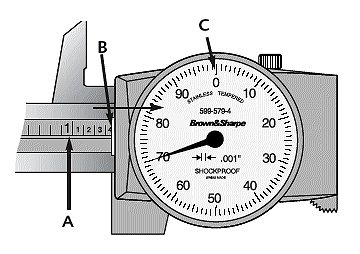
For example, in the image above you have 1.370 in.
Weight
The American silver eagle bullion coin has a published weight of 31.103 grams. Not every coin is going to weigh exactly this amount but should be very close. If you get 31.3 grams this is fine. Some Silver Eagles can weigh up to 31.8 grams and this is fine. They are supposed to weigh at least 31.1 grams but the production process both at the US Mint and the Mint's suppliers are not so perfect as to be able to produce exact 31.1 weights for every coin. The point here is that the coin should be at least 31.1 grams but if it is a few tenths of a gram more, this is perfectly fine.
If you want to check the weight of a tube of silver eagles, which is twenty coins, at one time, simply weigh the entire tube filled with the twenty coins. Silver eagles come from the mint in tubes of twenty coins. If you have several tubes you want to check and do not want to take the time to weigh each coin or you just want a quick check, weigh the entire tube in one shot.
What you should get is 668 grams to 672 grams for each tube of twenty coins. 669, or 670, or 671 grams is a very common result. This includes the weight of the twenty silver eagles plus the weight of the tube itself. Say each coin weighs about 31.3 grams times 20 equals 626 grams. The tube itself may weigh a little more than one coin or around 42 grams. Each tube's weight varies somewhat also, so put them both together and you get 668 grams.
How to weigh the coin:
Scales to weigh coins are either digital with an LCD readout or the older style triple beam balance scale. The triple beam scale has three parallel bars with weights you can move to balance the load until a marker is aligned even with the fixed line on the scale. Adjusting the weights allows for accurate readings down to the tenth of a gram.
Digital scales can give more precise readings but digital scales have to be calibrated often to be sure of accurate readings. Triple beam scales also need to be set properly to zero. Digital scales can cost hundreds of dollars for a good scale or if you prefer a less expensive digital scale, they are available. Triple beam scales vary but a good scale costs around $100 or more.
If you have a fake, it can weigh substantially more or less than the published number depending on which metals were used in the coin. However, fakes are sometimes very close to the published weight and require more testing.
Fakes can sometimes be discovered by weighing and measurement of coin dimensions because every material (brass, lead, copper, tungsten, aluminum, tin, zinc, gold, silver) has a certain weight and so using more or less of the material to achieve the proper weight would require the dimensions to go off. So if the weight AND the dimensions are correct, you can check off one criteria for establishing a real coin. That being said, some fakes are still possible even if the weight and dimensions are correct, although rare. It is possible to combine materials in such a way to achieve the weight/dimensions formula. Therefore more testing is required.
Ring / Bell Sound Test (Silver Bell)
The silver bullion coin will have a bell like ring when struck. After striking a known real silver bullion coin, get to know the sound. The expression "silver bells" is not far from the truth as pure silver, when struck, sounds just like a small bell ring. You can place a test coin on one finger held up and balanced, then carefully tap another silver coin against it and listen to the sound it makes. It should sound just like a bell and ring for a moment. If you hear a thud or clunk instead, it could be a fake, possibly lead or bronze with a silver exterior.
Magnet Test
Magnetism is a complicated area because metals exhibit complex magnetic behavior. Some metals are ferromagnetic like iron and nickel while other metals like gold (pure gold) and silver (pure silver) are not. Ferromagnetic means magnetism strong enough to be felt. To do a magnet test you should use a rare earth magnet (neodymium magnet), not a standard iron magnet. The magnet test is not definitive because several metals are not magnetic. So just because the coin does not attract the magnet does not mean it is not a fake.
The magnet test only discovers fakes made with metals that are magnetic. So this test just eliminates some fakes.
Copper, lead and silver are diamagnetic metals, meaning the effect of an external magnetic field is very small and is hardly noticable. So a fake could have lead, copper with an external surface covering of silver and the magnet test would not necessarily show the fake. But if the fake had any nickel, the magnet test would discover the fake. Brass (copper and zinc) is also not ferromagnetic.
Using a rare earth magnet, one can devise tests which can help to determine if a sample is pure silver because pure silver will show some small signs of magnetic attraction under certain test conditions. For example, a small rare earth magnet will be slightly attracted to pure silver. If your pure silver coin or bar shows absolutely no sign of magnetic attraction to a rare earth magnet, it could be a fake.
Marks and Appearance
Knowledge is key, and a good eye when looking for fakes. Know your coins, that is to say, know what a real coin should look like and what it should and should not have on each side. Look for the smallest details. Silver will tarnish over time if not kept in an air tight environment. The sulfur dioxide in the air will eventually form a dark layer on silver but this can be cleaned with baking soda and water or a silver cleaner with aluminum silicate as the abrasive to remove the tarnish. Older silver coins or even coins minted just a few years ago and not kept from air may show signs of tarnish. This would be normal for silver, however a fake can have silver on the exterior with a core of some other element. So tarnish is still not a foolproof indication.
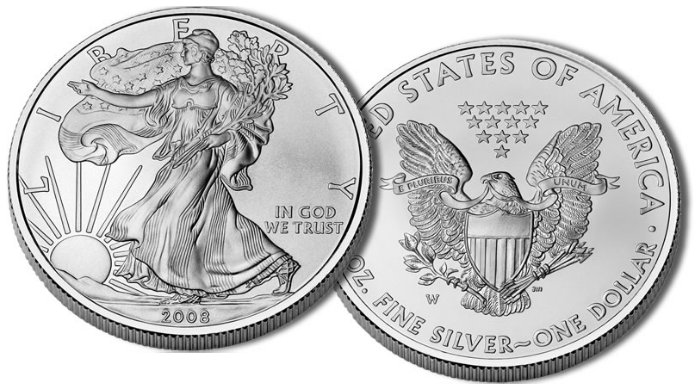
The American Silver Eagle Coin
In the above image of the Silver Eagle, notice the 13 five-pointed stars above the eagle. Notice E PLURIBUS and UNUM (many uniting into one) across the banner in the eagle's beak. Notice the shield, the arrows and the olive branch in the eagle's talons. United States Mint Sculptor-Engraver John Mercanti designed the reverse (tails side) and his initials are below the arrows. You will need a magnifying glass to read the JM.
Mint marks - The Mint Marks are below the olive branch on the reverse but not all silver eagles have one. Bullion Silver Eagle coins do not have mintmarks. From 1986 to 1998, they were minted at the San Francisco Mint. From 1999 to 2000, they were minted at Philadelphia and West Point. Since 2001, they have been minted only at West Point.
From 1986 to 1992, proof Silver Eagle coins were minted at the San Francisco Mint and these coins bear the "S" mintmark. From 1993 to 2000, they were minted at Philadelphia and these coins bear the "P" mintmark. From 2001 to 2008, they were minted at West Point and these coins bear the "W" mintmark. No proof versions were minted in 2009. Beginning again in 2010, the proof coins were minted at West Point and bear the "W" mintmark.
Proof silver eagle coins are collectable versions of the silver eagle coin and look different than bullion coins because of the mirror background. Like all modern proof coins, the Proof Silver Eagles feature frosted raised design elements over mirrored backgrounds. The term "proof" refers to a specialized minting process. American Eagle Proof Coins sell at a fixed price and can be purchased directly from the United States Mint by the public (when available) whereas bullion silver eagles cannot.
1 OZ. FINE SILVER - ONE DOLLAR is along the bottom and UNITED STATES OF AMERICA along the top. On the obverse (heads) side you should see IN GOD WE TRUST (lower right) and L I B E R T Y along the top. The year of minting is at the bottom and the SUN is depicted near the bottom left. Walking Liberty draped in the American flag is walking towards a new dawn with right arm extended and with left arm cradling branches of laurel and oak. Designed by Adolph A. Weinman, the Walking Liberty is also on the half-dollar (1916 - 1947).
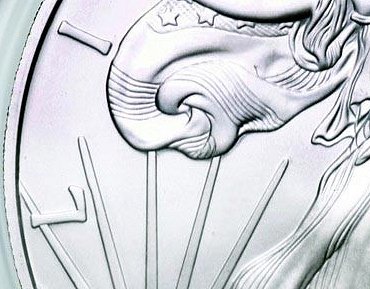
When looking for fakes, check the fine details on the coin. For example, a real silver eagle has the sun with rays extending which are rounded at the tip. One check is to look for the rounded tips on the sun's rays. If you see square tips for example, you may have a fake. Check the L in Liberty in the sun's rays. It should have a shape like a hockey stick on the lower part of the letter. It should also have a rounded look on the edges not squared off. If it has some other shape you may have a fake.
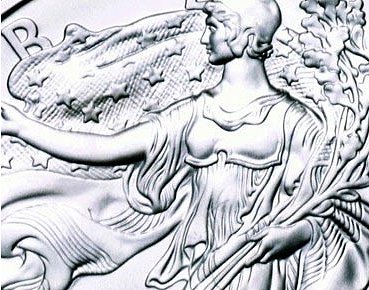
Look at the flag above the extended arm. It should have a 3 dimensional look to it, not a flat looking appearance. Notice the stars in the flag. Some are angled while some are front on. Get to know these type of details as well as the overall appearance of a real silver eagle coin. There is a certain luster which through experience you will see immediately when first looking at the coin.
Watch this video on silver eagle fakes
http://www.youtube.com/watch?v=5obdQClOrb0
Reeded Edge
Some silver coins have reeded edges while others are smooth. The American silver eagle has a reeded edge and you should always check for this feature. Also check the rim of the coin.
Dates of Issue
You may be surprised how often fake silver coins have the wrong year on them. American silver eagle coins were not minted prior to 1986 so if you see a silver eagle coin with a date of 1985 or before, you know it is a fake silver eagle. American silver eagle coins have the years 1986 to the present year on them. This is an easy check.
Ultrasonic thickness test
Sound travels in different materials at different speeds. This is the key to how ultrasonic thickness gauges (UTG) work. The speed at which sound travels through silver is known and is 3,650 M/s.
Measure the thickness of the coin or bar using a caliper. Enter the speed of silver into the UTG or inform the UTG you are testing silver. Place a drop of glycerin on the test item and put the probe into the glycerin. Test several areas. If the results on the UTG match the thickness measurement you took with the caliper, the bar or coin is real silver. Lead and tin will give slower readings while zinc, brass, copper, tungsten, iron, aluminum and stainless steel will give faster readings.
Specific Gravity Test
What is specific gravity?
Specific gravity is defined as the ratio of the density of a substance compared to the density of pure water. Since the density of pure water varies with temperature, one needs to specify the temperature of the pure water to usefully define specific gravity. For many scientific endeavors, the temperature standard chosen is 3.98 °C (39.2 °F; defined as the temperature of maximum density of pure water). At that temperature, the density of pure water is 1.0000 g/cm3.
The specific gravity for silver is 10.49 and its measurement can be taken by using various water displacement techniques. This test is one you can do if you have a scale, a calculator, some distilled water, some fine thread, and a suspension device to hold the sample in the water. Understanding how the test works involves some physics. The problem with this test is it requires a very high degree of accuracy. The number you end up with can be off by a margin which does not prove you have silver even though you may actually have silver. So the result can be inconclusive.The specific gravity of lead is 11.34, very close to silver. Copper is 8.96, also not too far off. The difference between using tap water or distilled water could result in 3 tenths of a gram difference and ultimately yield a specific gravity number closer to lead rather than silver. If the scale is off at all or if the readings or math are done incorrectly, the numbers do not prove anything. Additionally, the water must be at a standard temperature and pressure.
If you want to try the test, weigh the sample coin on the scale and write down the weight. For example 31.3 grams. Next, fill a plastic cup with distilled water. The cup has to be tall enough to fully contain the sample plus some water above. Next, weigh the water and cup on the scale. For example 306.5 grams.
Next, tie a fine thread around the sample coin or bar such that the sample stays in place and with enough to tie the sample up to a fixed device so that the sample is held up in place dangling from the top. A small tripod may work to hold up the sample.
Now lower the sample coin or bar into the water so that it is fully covered and not touching the sides of the cup and is not touching the bottom. Fix the thread to the device holding up the sample. Next, notice the scale has now changed so that the sample's mass is now included with the water and cup's weight. What is the difference between the two readings?
For example, an increase of 3.1 grams. Divide the 3.1 into the 31.3 from the dry weight of the sample and you get 10.1 which would be the specific gravity. Pure silver is 10.49 so you know the sample is fairly close to pure silver. If you get a number for the specific gravity which is way off, either you did the test wrong or the coin is suspect.
Try the test again with colder water, say around 40 deg F to see if the specific gravity number is slightly different.
Mass Spectrometer
Mass spectrometry is a technique for analyzing the molecular structure of a chemical structure. For precious metals ICP-MS (Inductively-coupled plasma mass spectrometry) is used to detect and separate the ions of the metal and is very accurate. The problem is these instruments are extremely expensive and fall outside the realm of the average consumer. It is only mentioned here to inform those who may want to take their testing to the next level that indeed there are available methods to do exactly that.
Acid Tests
This test will essentially destroy the value of your coin so only do this if you think you have a fake from performing the other tests and you do not care about selling the coin or bar except as scrap metal.
The process involves inflicting the coin in question with a deep scratch, pouring some nitric acid into that scratch and then matching the resulting color with the color chart that came with the silver testing kit.
Bottles of the acid (nitric, muriatic) are inexpensive, only a few dollars but very dangerous so BE CAREFUL with the acid. Wear gloves and eye protection. Drip a small drop of the acid from the bottle on the coin and wait about 20 to 30 seconds. The acid will turn color to a blue/green if a fake. If real silver, the acid will remain a dark reddish brown color. Some bars can be silver coated so the scratch has to be deep enough to get through the silver on top.
Grinding or filing
This is a destructive method and involves essentially destroying the coin or bar. You would only do this if you had a strong suspicion that the coin or bar is NOT silver and have exhausted all other tests. You could also do this test if you knew that you were going to just melt down the coin or bar for sale as base metal. Basically you would grind or file off the exterior surface in order to see what is below. By taking off the surface material you would expose the underlying fake material. You may see a different color other than silver such as brass or copper or lead and of course this tells you what you suspected before that indeed you have a fake.
• Silver content of U.S. coins
Silver Bullion - Coins and Bars
The U.S. Mint produces each year the American Silver Eagle bullion coin, a 1 troy oz. coin of .999 fine silver with a face value of one dollar.
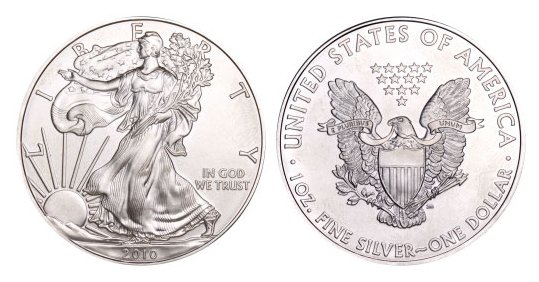
The Silver Eagle dollar was first released by the U.S. Mint on November 24, 1986. It contains one troy ounce of .999 Pure Silver, and has a nominal Face Value of One Dollar. Its weight and content is certified by the U.S. Mint. For coin collectors, the U.S. Mint produces a proof version of the coin. The Silver Eagle dollar has been produced at three minting locations, including Philadelphia (‘P’ mintmark), San Francisco (‘S’ mintmark) which issued proofs, and more recent proofs from West Point.
An authentic Silver Eagle dollar will weigh at least 31.103 grams, and its diameter is 40.60 mm, with a thickness of 2.98 mm. Its edge must be reeded, and the Silver content is 99.9%. The obverse design features walking Liberty and is adapted from the design of Adolph A. Weinman during the year 1916. The reverse design features a Heraldic Eagle with Shield, 13 stars, and United States of America on top, which was designed by John Mercanti in 1986.
How much to pay for SILVER - Silver Premiums
Silver Buyer Education
The following is for the benefit of silver buyers. Knowing the silver market is key to getting your money's worth when buying. Education on this topic is vital for buyers as the sellers are already educated and have an advantage over you if you do not know the market. Ebay is a prime example of some silver sellers taking advantage of uninformed silver buyers not knowing how much to pay for silver.
A silver seller/dealer can ask any price they want for their silver. However the informed buyer should only pay the going price, not some higher price asked by a seller/dealer who could be described as nothing short of a thief by taking much more of your money than other, more honest dealers.
The price of the silver you buy is determined by two prices, which, when added together, result in the final price you pay. One price is called the SPOT price and the other price is called the PREMIUM. The spot price is the current price of silver as determined by the worldwide market in silver. This price changes all the time, fluctuating constantly based upon countless market conditions.
The spot price for silver can be viewed online at most large silver dealers. As you will notice, the spot price changes up and down over time. Trends can be viewed as well over days, months and years. Basically spot, as it is called, is what large buyers are willing to pay right now for an ounce of silver. The spot price makes up the larger part of the price. This is what you are paying for the silver itself. The premium is the second part of the total price. The premium is a seller/dealer add-on charge. The seller will add a premium to cover costs but also to make a nice profit. As a buyer, you want to make sure the seller's profit is not excessive, because if it is, you got taken for more money than the going rate.
What is a fair premium?
The buyer should remember that the seller/dealer makes money either way, selling or buying. If the seller did not make a nice profit, soon they would be out of business. So yes, the seller should do well, but how well, that is the question. Silver demand and supply factors into price as well as premium. In 2012, silver was in great demand. The premium on one ounce of silver was $2 over spot and up, with $3 to $4 over spot being a good and fair seller charge. Sellers asking, for example, $6 or more over the current spot price in 2012 would have been considered to be making an excessive profit. In other words, taking advantage of a buyer.
Premiums can be calculated as a percentage. This is another way to look at the price. For example if spot silver was $30 and the seller was asking $3 over spot ($33) then the premium would be 10 percent. Think about a 10 percent margin on another item and compare value. The seller is asking 10 percent in addition to the silver cost. If the seller paid $1 over spot for an ounce of silver from the supplier, then the other $2 is potential profit, minus business costs. But that is on each coin and it all adds up fast.
Of course supply and demand create changing markets and prices will change accordingly. The point is the buyer should be informed. The buyer needs to know what is a good price for the current market. Shop around to find the best deal. Know the current spot price and calculate the premium. Premiums of $3 to $4 over spot are considered to be good for the American Silver Eagle coin. Any higher premium is to be questioned.
https://libertycpm.com/silver/silver-american-eagles/
https://libertycpm.com/
The links above have been found to be good for silver buyers. The premiums are reasonable as of June 2013. Compare the premiums to any Ebay seller or other dealer you might be considering and make your decision. You just may save yourself a lot of money.
• Silver Coins
• Silver Coins International
• Gold Coins and jewelry
• Gold Eagle
• Gold Maple Leaf
• Krugerrand
• Diamonds Buying Guide
• Diamond Rings
• How to tell if a Diamond is real
• What is moissanite?
• How to read a diamond certificate
Bullion Dealers and Coin Links
Provident Metals
• Provident Metals
Gold, Silver, Platinum, Copper, Palladium, U.S. and foreign coins
Order by phone 877-429-8790
Provident
PO Box 325
Lavon, TX 75166
sales@providentmetals.com
• Omega Precious Metals, Inc.
18 Village Square Glen Cove, New York 11542
1-800-474-6960 or 516-759-6960 Fax: 516-759-6979
Email: JoeHylas@AllCoins.US
• OnlyGold
CSG Inc. 4216 West Dunlap Avenue, Phoenix AZ 85051-3654
1-800-800-4485
• Certified Coin Exchange
• Wexford Coin Wexford Capital Management David W. Young, President 113 Brenton Court Stephens City, Virginia 22655-4819 (877) 855-9760 Fax (866) 611-3526
• Tulving
• Gold coins bullion
• Encore gold Encore Gold, LLC 307 Division Street Northfield, MN 55057 (877) 563-8736
• Fort Worth Coin
• Gold central
• Goldline
• Coin maven
• Coins plus
• Gold coins
• MJPM
• USA Gold
• AJPM
• Amerigold
• APMEX
• Austin Coins
• Blanchard
• Coin guy
• Gold dealer
• Camco coin
• Certified gold exchange
• Certified Mint
• Goldmasters USA
• Coin guide
• Precious metals
• Jack Hunt Kenmore N.Y. 14217 (800)877-7424
• JT Coins
• Louisiana gold
• Merit Financial
• The US Mint - Current Mint Issues
• US Bureau of Engraving - Currency for the Collector
PCGS - Professional Coin Grading Service
NGC - Numismatic Guarantee Corporation
ANACS - American Numismatic Authentification Certification Service
I.C.T.A. - Industry Council for Tangible Assets
• World Gold Council